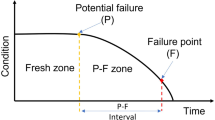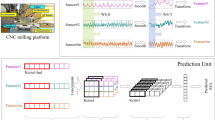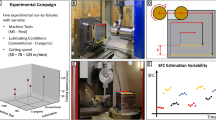Abstract
A sustainable and reliable machining process is the main goal of seeking machine digitization. Artificial Intelligence (AI), and Cyber-Physical System (CPS) combined with Artificial Intelligence are used for process control. This has become more essential in the case of machining of high-cost aerospace materials and critical product specifications. In this paper, a novel self-healing mechanism was developed to recover a CNC machine from producing parts that do not conform, to surface roughness’s specifications. The machine settings are reconfigured autonomously and online to recover from the effect of tool wear and to keep the surface roughness within the design specifications. The proposed self-healing mechanism is based on a pattern recognition algorithm called Logical Analysis of Data (LAD). This algorithm generates patterns that characterize the out-of-specification state, and provides a corrective setting within the recovery patterns of the within-specification state by using various distance approaches. The developed self-healing mechanism is composed of three modules: CPS model of the CNC machine (module 1), classification into, out of, or within-specification states (module 2), and a self-healing controller (module 3) that is activated if the state of out-of-specification is found by module 2. The three modules are software. The current hardware system of the machine is not altered. The proposed self-healing is applicable and integrable to CNC machines with a wide range of machining parameters of feed rate from 20 mm/min to 750 mm/min and spindle speed from 15,000 RPM to 35,000 RPM. To validate the developed mechanism, a deep learning artificial model was developed on physical data to emulate the CNC milling machine in a CPS simulation environment, and test runs were executed. The proposed self-healing mechanism was evaluated under several simulation runs that covered the ranges of CNC machine settings. The measure of performance of the proposed mechanism is the out-of-specification clearing time. The test runs show that the proposed self-healing mechanism was able to clear the out-of- specification state and to recover the within-specification state in less than five seconds, with the best distance metric approach. The results of the time response for each test run are reported.









Similar content being viewed by others
References
Abbas, A. T., Abubakr, M., Elkaseer, A., Rayes, M. M. E., Mohammed, M. L., & Hegab, H. (2020). Towards an adaptive design of quality, productivity and economic aspects when machining AISI 4340 steel with wiper inserts. IEEE Access, 8, 159206–159219. https://doi.org/10.1109/ACCESS.2020.3020623.
Aggarwal, C. C. , Hinneburg, A. , & Keim, D. A. (2001). On the surprising behavior of distance metrics in high dimensional space. In International conference on database theory (pp. 420–434). https://doi.org/10.1007/3-540-44503-X_27
Amin, A. A., & Hasan, K. M. (2019). A review of fault tolerant control systems: Advancements and applications. Measurement, 143, 58–68. https://doi.org/10.1016/j.measurement.2019.04.083
Bennane, A., & Yacout, S. (2012). Lad-cbm; new data processing tool for diagnosis and prognosis in condition-based maintenance. Journal of Intelligent Manufacturing, 23(2), 265–275. https://doi.org/10.1007/s10845-009-0349-8
Brownlee, J. (2016). Deep learning with python: develop deep learning models on theano and tensorflow using keras. Machine Learning Mastery.
Cus, F., Zuperl, U., & Gecevska, V. (2007). High speed end-milling optimisation using particle swarm intelligence. Journal of Achievements in Materials and Manufacturing Engineering, 22(2), 75–78.
Elsheikh, A., Yacout, S., & Ouali, M.-S. (2019). Bidirectional handshaking lstm for remaining useful life prediction. Neurocomputing, 323, 148–156. https://doi.org/10.1016/j.neucom.2018.09.076
Elsheikh, A., Yacout, S., Ouali, M.-S., & Shaban, Y. (2020). Failure time prediction using adaptive logical analysis of survival curves and multiple machining signals. Journal of Intelligent Manufacturing, 31(2), 403–415. https://doi.org/10.1007/s10845-018-1453-4
Hoang, T.-D., Nguyen, Q.-V., Nguyen, V.-C., & Tran, N.-H. (2020). Self-adjusting on-line cutting condition for high-speed milling process. Journal of Mechanical Science and Technology, 34(8), 3335–3343. https://doi.org/10.1007/s12206-020-0726-y
Huang, S., Tan, K. K., Hong, G. S., & San Wong, Y. (2007). Cutting force control of milling machine. Mechatronics, 17(10), 533–541. https://doi.org/10.1016/j.mechatronics.2007.07.005
Jouan-Rimbaud, D., & De Maesschalck, R. (2000). The mahalanobis distance. Chemometrics and Intelligent Laboratory Systems, 50, 1–18. https://doi.org/10.1016/S0169-7439(99)00047-7
Karray, M. H., Ameri, F., Hodkiewicz, M., & Louge, T. (2019). Romain: Towards a bfo compliant reference ontology for industrial maintenance. Applied Ontology, 14(2), 155–177. https://doi.org/10.3233/AO-190208
Kumar, S. , Chow, T. W. , & Pecht, M. (2009). Approach to fault identification for electronic products using mahalanobis distance. IEEE Transactions on Instrumentation and Measurement. https://doi.org/10.1109/TIM.2009.2032884
Lee, J., Ghaffari, M., & Elmeligy, S. (2011). Self-maintenance and engineering immune systems: Towards smarter machines and manufacturing systems. Annual Reviews in Control, 35(1), 111–122. https://doi.org/10.1016/j.arcontrol.2011.03.007
Li, J., Fong, S., Wong, R. K., & Chu, V. W. (2018). Adaptive multi-objective swarm fusion for imbalanced data classification. Information Fusion, 39, 1–24. https://doi.org/10.1016/j.inffus.2017.03.007
Luo, W., Hu, T., Zhang, C., & Wei, Y. (2019). Digital twin for cnc machine tool: modeling and using strategy. Journal of Ambient Intelligence and Humanized Computing, 10(3), 1129–1140. https://doi.org/10.1007/s12652-018-0946-5
Meshreki, M. , Sadek, A. , & Attia, M. (2012). High speed routing of woven carbon fiber reinforced epoxy laminates. In Asme international mechanical engineering congress and exposition (Vol. 45196, pp. 2061–2066). https://doi.org/10.1115/IMECE2012-88616
Mhaskar, P., Liu, J., & Christofides, P. D. (2012). Fault-tolerant process control: Methods and applications. Berlin: Springer Science & Business Media. https://doi.org/10.1007/978-1-4471-4808-1
Moreira, L. C., Li, W., Lu, X., & Fitzpatrick, M. E. (2019). Supervision controller for real-time surface quality assurance in cnc machining using artificial intelligence. Computers & Industrial Engineering, 127, 158–168. https://doi.org/10.1016/j.cie.2018.12.016
Park, H.-S., & Tran, N.-H. (2014). Development of a smart machining system using self-optimizing control. The International Journal of Advanced Manufacturing Technology, 74(9–12), 1365–1380. https://doi.org/10.1007/s00170-014-6076-0
Rawat, S., & Attia, H. (2009). Characterization of the dry high speed drilling process of woven composites using machinability maps approach. CIRP Annals, 58(1), 105–108. https://doi.org/10.1016/j.cirp.2009.03.100
Sadek, A., Hassan, M., & Attia, M. (2020). A new cyber-physical adaptive control system for drilling of hybrid stacks. CIRP Annals, 69(1), 105–108. https://doi.org/10.1016/j.cirp.2020.04.039
Seguy, S., Insperger, T., Arnaud, L., Dessein, G., & Peigné, G. (2010). On the stability of high-speed milling with spindle speed variation. The International Journal of Advanced Manufacturing Technology, 48(9–12), 883–895. https://doi.org/10.1007/s00170-009-2336-9
Shaban, Y., Meshreki, M., Yacout, S., Balazinski, M., & Attia, H. (2017). Process control based on pattern recognition for routing carbon fiber reinforced polymer. Journal of Intelligent Manufacturing, 28(1), 165–179. https://doi.org/10.1007/s10845-014-0968-6
Shaban, Y., Yacout, S., & Balazinski, M. (2015). Tool wear monitoring and alarm system based on pattern recognition with logical analysis of data. Journal of manufacturing science and engineering. https://doi.org/10.1115/1.4029955
Silva, G. C., Carvalho, E. E., & Caminhas, W. M. (2020). An artificial immune systems approach to case-based reasoning applied to fault detection and diagnosis. Expert Systems with Applications, 140, 112906. https://doi.org/10.1016/j.eswa.2019.112906
Taha, H. A. , Sakr, A. H. , & Yacout, S. (2019). Aircraft engine remaining useful life prediction framework for industry 4.0. In 4th north america conference on industrial engineering and operations management, toronto, canada.
Taha, H. A. , Yacout, S. , & Birglen, L. (2021). Detection and monitoring for anomalies and degradation of a robotic arm using machine learning. In Advances in automotive production technology–theory and application (pp. 230–237). Springer. https://doi.org/10.1007/978-3-662-62962-8_27
Vogl, G. W., Weiss, B. A., & Helu, M. (2019). A review of diagnostic and prognostic capabilities and best practices for manufacturing. Journal of Intelligent Manufacturing, 30(1), 79–95. https://doi.org/10.1007/s10845-016-1228-8
Wang, J., Ye, L., Gao, R. X., Li, C., & Zhang, L. (2019). Digital twin for rotating machinery fault diagnosis in smart manufacturing. International Journal of Production Research, 57(12), 3920–3934. https://doi.org/10.1080/00207543.2018.1552032
Weinberger, K. Q. , & Saul, L. K. (2009). Distance metric learning for large margin nearest neighbor classification. Journal of machine learning research10(2). 207–244
Wu, Z., Wu, Y., Chai, T., & Sun, J. (2014). Data-driven abnormal condition identification and self-healing control system for fused magnesium furnace. IEEE Transactions on Industrial Electronics, 62(3), 1703–1715. https://doi.org/10.1109/TIE.2014.2349479
Yacout, S. (2019). Industrial value chain research and applications for industry 4.0. In In 4th north america conference on industrial engineering and operations management, toronto, canada.
Yang, J., Lu, S., & Wang, L. (2020). Fused magnesia manufacturing process: a survey. Journal of Intelligent Manufacturing, 31(2), 327–350. https://doi.org/10.1007/s10845-018-1448-1
Zhang, W.-J., & Lin, Y. (2010). On the principle of design of resilient systems-application to enterprise information systems. Enterprise Information Systems, 4(2), 99–110. https://doi.org/10.1080/17517571003763380
Zuperl, U., Cus, F., & Reibenschuh, M. (2012). Modeling and adaptive force control of milling by using artificial techniques. Journal of Intelligent Manufacturing, 23(5), 1805–1815. https://doi.org/10.1007/s10845-010-0487-z
Acknowledgements
This research was financed by the Mitacs research grant reference IT19389 that was awarded to the corresponding author in autumn 2020.
Author information
Authors and Affiliations
Corresponding author
Additional information
Publisher's Note
Springer Nature remains neutral with regard to jurisdictional claims in published maps and institutional affiliations.
A Appendix
A Appendix
While running the 20 sets sequentially that are labeled as out-of-specification, we compared the recovery time of the P2D and the P2P distance approaches. The P2D self-healing outperforms the P2P and recovers the out-of-specification state of the CNC machine faster than with P2P. This result was obtained when the initial settings were the \({2{nd}, 7{th}, 8{th}, and\; 9{th}}\) that are shown in Table 8 and Table 9. This behavior happened in 4-runs out of 20 runs, which led to out-of-specification as shown in Table 8. In 9 settings out of the 20, the recovery time was found to be the same for the P2D and the P2P approaches. In this case, the selection of a recovery pattern does not affect recovery time. Finally, seven settings led to a longer recovery time with the P2D than with the P2P.
A.1 7th, 8th, and 9th initial settings
These initial sets are different in feed rate and are common in 4\({\times 10^4}\) RPM spindle speed and with a 32 mm non-variable depth of cut. The different feed rate settings led to different faulty forces and temperature measurements for each initial set, as indicated in Table 8. In these runs, P2D-Self-healing outperforms the P2P-Self-healing, and it recovers the CNC machine Ra fault in 3.5 seconds as shown in Figs. 6a, 7a, and 8a. The P2D approach calculates the distance to each recovery pattern by considering it as uniform distribution. The P2P distance was calculated to a recovery pattern mean as a single point regardless of the other corrective values inside the pattern. P2D-Self-healing selects the 3rd recovery pattern to be the nearest pattern in the first 5 cycles, which is the same as P2P. Then, it selects the 1st recovery pattern instead of the 3rd pattern at a time of 3 seconds, while the P2P-self-healing recovers the Ra out-of-specification in 18 seconds with the 1st recovery pattern, as given in Figs. 7b, 8b, and 9b. In these initial sets, the P2P-Self-healing cleared the detected fault with the corrective action of changing the initial settings to 499.3 mm/min feed rate and spindle speed to 3.56\({\times 10^4}\) RPM. Consequently, the fault detection symptoms of the force in the x-direction given in Figs. 7d, 8d, and 9d, \({F_x}\) were changed from the values that cause a fault in each run to a normal value of 18.3 N. P2D-self-healing corrective settings are 308.2 mm/min feed rate and 3.13\({\times 10^4}\) RPM spindle speed. As a result of changes to the settings, the faulty force in the x-direction for each initial set, \({F_x}\) was changed to 15 N as presented by Figs. 7d, 8d, and 9d, and the mean temperature decreased to 243.5 C\({^o}\), as given in Figs. 7f, 8f, and 9f.
A.2 P2D and P2P have the same recovery time
In the runs of this behavior, the distance approaches of P2D and P2P do not affect Self-healing performance, and it has the same fault recovery performance for the two approaches. The performance equalizations exist in 9 runs out of the 27 runs that are indexed \({[18{th} - 27{th}]}\) with excluding the conformed settings 25th initial set.
A.2.1 18th initial settings
In this run, we set the CNC machine initially with faulty settings of a non-variable 64 mm cutting depth, a feed rate of 700 mm/min, and 4\({\times 10^4}\) RPM spindle speed. P2P and P2D Self-healing select the 2nd recovery pattern to be the nearest pattern to the 18th initial settings, as identified by Fig. 10b. The self-healing module achieves the same fault recovery time of 1 second for the two distance approaches, as given in Fig. 10a. The self-healing corrective actions are 358.5 mm/min, 3.9\({\times 10^4}\) RPM with P2P self-healing, while P2D self-healing generates 367.2 mm/min and 3.7\({\times 10^4}\) RPM for the feed rate and speed, respectively. The fault cause was the \({F_x}\) sensor that has a high value of 26.8 N at the incident of the fault, and with the self-healing action, it was reduced to normal values of 20.2 N, as depicted by Fig. 10d. The mean temperature decreased from 355.3 \({C^{o}}\) to 297.4 \({C^{o}}\) with P2P, and to 290 \({C^{o}}\) with P2D, as presented in Fig. 10f.
A.2.2 19th, and 20th initial sets
The CNC machine’s initial faulty settings are 96 mm non-variable depth of cut, 1\({\times 10^4}\) RPM spindle speed, and the feed rate is 100 mm/min for the 19th set and 400 mm/min for the 20th initial set. According to the depth of cut, the nearest possible recovery pattern to be selected is the 4th pattern out of the recovery patterns in Table 6. Therefore, in these runs, the distance approaches do not influence the self-healing module performance, and it has the same self-healing corrective actions of 200.3 mm/min feed rate and 2.94\({\times 10^4}\) RPM spindle speed with P2P and P2D self-healing, as recorded by Fig. 11c and e. The Self-healing module clears the detected out-of-specification fault within 1.5 seconds, as given in Fig. 11a. As the initial feed rate is different in the 19th and 20th initial sets, the faulty measurements of forces and temperature are different for each initial set, as indicated in Fig. 11d and e. CNC milling x-access force was the main fault indicator in the 19th and 20th runs, and it decreased with self-healing actions to 24.0 N; while the mean temperature changed to 294.4 \({C^{o}}\), as exhibited in Fig. 11d and e.
In the 21st, 22nd, 23rd, 24th, 26th, and 27th runs, the self-healing with either P2P or P2D has the same fault recovery time, and it clears the CNC machine fault in 1.5 seconds, as mentioned in Fig. 12a. The depth of cut is the common setting in all these runs, and it is 96 mm; therefore, the 4th recovery pattern is the nearest possible pattern as in the 20th run. The self-healing actions to recover the Ra fault are the same values of 200.3 mm/min for the feed rate and 2.94\({\times 10^4}\) RPM for the spindle speed, as mentioned in Fig. 12c and e. For all these 6 runs, the \({F_x}\) is the main cause of the Ra fault and it activated the 1st IF-THEN detection rule in “Out of specification detection modeling” section. The faulty \({F_x}\) sensor values were 69.9 N, 55.3 N, 41.8 N, 41.8 N, 40.7 N, 29.7N, and 28.1 N for the 21st, 22nd, 23rd, 24th, 26th, and 27th Runs respectively, and it changed with a self-healing module to 24 N, as shown by Fig. 12d.
A.3 P2P is better than P2D in recovery time
This is the last kind of Self-healing performance, and it was in 7 runs out of the 27 runs. However, P2D and P2P approaches select the same nearest recovery pattern in each run of these 7 runs; Self-healing P2P outperforms P2D self-healing, and it recovers the CNC machine Ra fault in fewer time steps than with P2D distance. In the 3rd, 4th, and 6th runs, P2P and P2D Self-healing selects the 6th recovery pattern to recover the out-of-specification fault, as presented in Figs. 13.3.b, 13.4.b, and 13.6.b, respectively. The P2D self-healing recovers the Ra fault within 2.5 seconds, while the recovery time was 2 seconds with P2P self-healing, as indicated in Fig. 13.6. In the remaining 4 initial sets out of the 27, the 5th recovery pattern is selected to be the nearest to clear the Ra faults in the 10th, 11th, 12th, and 15th runs, according to the P2P and P2D distance calculations. P2P Self-healing clears the CNC machine fault within 1 second, while it is cleared in 1.5 seconds with P2D, as given in Fig. 14.
The P2D Self-healing minimum execution time was 1.9 mseconds and it is achieved at the 12th run, while the maximum P2P execution time was 2 \(\mu \)seconds at the 15th run, as stated in Fig. 15. Hence, the P2D self-healing recovers the fault within the next fault detection cycle of 0.5 seconds later than P2P-self-healing.
The execution time of Self-healing with P2D distance depends on the number of corrective sample points inside the recovery pattern, which are sampled from the pattern range to calculate the covariance matrix (Cov). While, P2D-self-healing would be more accurate with a higher number of samples, its exclusion time would increase. The number of recovery samples used in all 27 runs was 1000 samples. When we decrease the number of samples to 10 samples per recovery pattern, a P2D Self-healing execution becomes small and almost equal to the P2P-Self-healing execution time. Moreover, the fault recovery time gets faster, the same as with P2P self-healing, in these 7 runs as given in Fig. 15.
Rights and permissions
About this article
Cite this article
Taha, H.A., Yacout, S. & Shaban, Y. Autonomous self-healing mechanism for a CNC milling machine based on pattern recognition. J Intell Manuf 34, 2185–2205 (2023). https://doi.org/10.1007/s10845-022-01913-4
Received:
Accepted:
Published:
Issue Date:
DOI: https://doi.org/10.1007/s10845-022-01913-4










